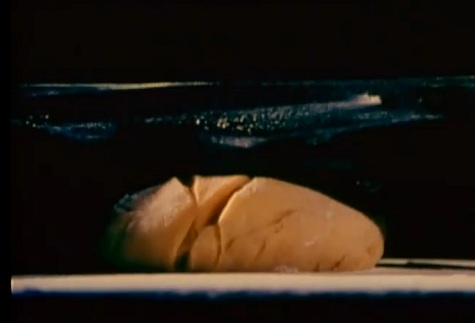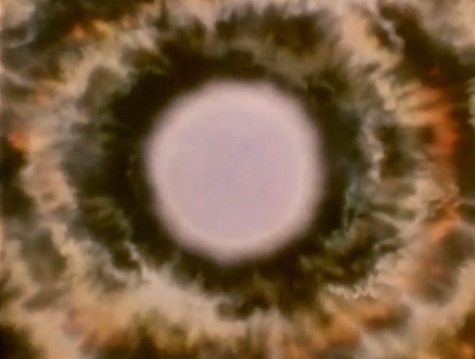The ninth episode of Cosmos, “The Lives of the Stars,” is about things very small (atoms) and very large (stars). Sagan begins with a discussion of atoms—how they’re put together, how we discovered them, etc. He also explains the elements, and how the simple addition or subtraction of protons creates all of the different building blocks of life and the universe. From the elements, we move on to the stars—the sources of these building blocks (and also made of them), stars are the huge things that are connected intimately to the smallest things. The different types of stars, their life cycles, and their composition are also discussed. It’s a chain of related information, delivered with wit and joy.
This is a more playful episode than the last, possibly because of Sagan’s enthusiasm for the guiding idea that we are all connected to the cosmos by our atoms, as well as his poetic embrace of the connection between the huge and the miniscule. There are a ton of little jokes in this episode that I enjoyed. The progression of the narrative is straightforward, too—it makes sense to begin with the tiniest building blocks, then move on to the biggest things that they make up and how those things in turn create more elements to seed the universe with matter and life.
“I’ve been to a couple of parties like that myself,” Sagan says while discussing gravity changes flinging around the characters of Alice in Wonderland so that it rains tea and everyone falls about.

The dramatic apple slicing, dough making and pie baking that opens this episode is genuinely hilarious, particularly without real context. The high drama of the roller descending on the ball of dough, accompanied by intense music, is enough to make me snort with laughter every time I see it. It’s just so delightfully silly. Of course, it leads somewhere useful, the metaphor of slicing the apple pie smaller and smaller and smaller—“If you wish to make an apple pie from scratch, you must first invent the universe.”—but it’s the weirdest opener in the entire series. (Not that I mind weird; I love it. I especially like the playfulness of being willing to open with something so intentionally over-the-top. The attempt to write the googolplex on the strip of paper, which Sagan then winds all around Cambridge, is both a visual gag and a thought experiment, too.)
The pie lets Sagan explain a key idea, the topic of this episode: the big and the small. When we look up at the night sky we confront an infinity of the very large, while the atom is an infinity of the very small, “an unending regress.” And yet, as this episode slowly illustrates, they are one and the same. This simple coherence—the laws that structure our universe, the connections that make it all of a piece—is moving, and Sagan’s clear emotional engagement with communicating this vital interconnectedness is as evocative now as it was thirty years ago.
As the astrology episode noted first, and Sagan explains in greater scientific detail here: we are connected to the cosmos, and not in a trivial way but in the ultimate way. We’re made of it; it’s made of us. It’s a beautiful thing, the idea that we’re all made of star stuff, one that Cosmos comes back to over and over again—cosmos over chaos, order and connection over disarticulation and the random. For the spiritually inclined, it seems to offer a scientific way of understanding the condition of life as opposed to the religious superstition Sagan distrusts. Poetry is, in a sense, spiritual—a matter of inventive “spirit” if nothing else—and so I’m not surprised by how many folks have found inspiration in this series’ focus on the real connections between living beings and the universe we inhabit. Sagan doesn’t make a huge deal out of it; he just offers it, as a gift of knowledge. That generosity, the opposite of Pythagorean elitism, is what makes Cosmos and Sagan’s work—as well as that of current science popularizers, like Neil deGrasse Tyson—so damned valuable.

This is, as I’ve implied, a very poetic episode, too. It’s one of those that spends a lot of time with Sagan in nature, interacting with objects, etc. The ship of the imagination is back, too. When discussing the death of a star, Sagan calls the gas that blows away from it a “shroud” and a “silk bubble,” both strong images—one of death, one of delicacy. Accompanied by the images of gaseous clouds, vibrant with color, in space, this poetry is particularly evocative. Sagan’s love for the stars is clear in the energy he puts toward explaining their life cycles and their significance to the audience. He wants everyone to think stars are as cool as he does—to put it very simply—and I’d say he’s successful in that venture. The personification of the stars in the second half of the episode, discussing as Sagan does their “deaths,” their “siblings,” their “nurseries” and their “wandering,” is another way of offering emotional connections to the distant vastness of the universe. There are also shots like that of his hand picking up a fistful of glass vials and throwing them, glittering, into the air—where they then land, all in order, on a periodic table.
Aside from interconnectedness, there’s another idea that’s small-but-massive here: atoms and how they’re constructed. As Sagan says, “Atoms are mainly empty space. Matter is composed chiefly of nothing.”
Well. That thought is one that gives me pause, and provokes at least a moment of thought. “Matter is composed chiefly of nothing,” indeed. That’s a powerful thought, considering how immersed in matter we are—we’re made of it, after all—and one that has always prompted me to sit back and consider it for awhile. The idea that the majority of an atom is empty space makes the density of matter seem improbable, and yet, here we are: my fingers don’t slip through this keyboard.
It also wouldn’t be on at all if I didn’t mention one of the other favorite things I noticed in this rewatch that I didn’t remember noticing before: there’s a Pink Floyd song playing in the background of the “supernova” that we “observe” in the ship of the imagination! It’s “One of These Days,” and I nearly spat my tea out when the strumming bass-line came in. It distracted me entirely for a moment from the visual effects of the supernova, which is a really lovely scene. Most of this series’ soundtrack is provided by Vangelis, so the sudden appearance of this song was neat and weird.

Neat and weird, too, are the psychedelic visual effects near the end of the episode when Sagan is discussing black holes, wormholes, and travel through them. The animations may be dated, but they’re still dizzying and delightful to watch slip and slide across the screen as dimensions are inverted and turned in on themselves. So, so very pretty.
And then, we have this, to close: “It makes good sense to revere the sun and the stars, because we are their children. We have witnessed the life cycles of the stars. They are born, they mature, and then they die. […] Our matter and our form are determined by the cosmos of which we are a part.”
Interconnectedness, right?
*
Come back next week for episode 10, “The Edge of Forever.”
Lee Mandelo is a writer, critic, and editor whose primary fields of interest are speculative fiction and queer literature, especially when the two coincide. She can be found on Twitter or her website.











The apple… Was this the episode that introduced me to “Flatland”?
“The idea that the majority of an atom is empty space makes the density of matter seem improbable, and yet, here we are: my fingers don’t slip through this keyboard.”
The thing is, Sagan wasn’t quite right when he said matter consists mostly of nothing. That “nothingness” between particles is filled by fields of energy and force. What we perceive as the solidity of the objects we touch is actually an energy effect — the electrical repulsion between the surface electrons of our skin and the surface electrons of the things we’re touching. Something we think of as completely intangible, the electromagnetic field, is actually the source of everything we perceive as tangibility and solidity.
@2 ChristopherLBennett
You are corect, yet, Sagan was also currect as far as the point he was making. He was talking about the particle parts of the atom. This was meant to be an intorduction to the concept (or a refresher for those adults who had forgotten their high school science), not a college lecture.
I find it interesting that there is another parallel between the stars and atoms – the complex forces involved in maintaining their forms. Additionally. I look at that movie of the atoms and I wonder if I’d see something like that if I could make a movie of all the forces and energies surrounding the stars in space.
@wiredog
That’s in episode 10, “The Edge of Forever.”
@Ludon
Additionally. I look at that movie of the atoms and I wonder if I’d see
something like that if I could make a movie of all the forces and
energies surrounding the stars in space.
That would be interesting to see.
I’m sure that it is the apple pie line that inspired this comic. Pratchett noted in Science Of The Discworld that it must be the most complicated way to make an apple pie, and it would be easier to make one by randomly arranging atoms. I don’t remember where he found the atoms though.